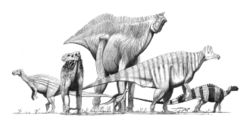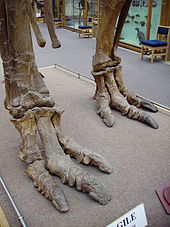- Ornithopod
-
Ornithopods
Temporal range: Middle Jurassic - Late Cretaceous, 169–65.5 Ma
Various ornithopod dinosaurs.
Far left: Camptosaurus, left: Iguanodon, centre background: Shantungosaurus, centre foreground: Dryosaurus, right: Corythosaurus, far right (small): Heterodontosaurus (probably not an ornithopod), far right: Tenontosaurus.Scientific classification 
Kingdom: Animalia Phylum: Chordata Class: Reptilia Superorder: Dinosauria Order: †Ornithischia Node: †Cerapoda Suborder: †Ornithopoda
Marsh, 1881Families - Camptosauridae
- Dryosauridae
- Hadrosauridae
- Hypsilophodontidae*
- Iguanodontidae
- Rhabdodontidae
Ornithopods (
 /ɔrˈnɪθɵpɒd/) or members of the clade Ornithopoda (/ɔrnɨˈθɒpədə/) are a group of ornithischian dinosaurs that started out as small, bipedal running grazers, and grew in size and numbers until they became one of the most successful groups of herbivores in the Cretaceous world, and dominated the North American landscape. Their major evolutionary advantage was the progressive development of a chewing apparatus that became the most sophisticated ever developed by a reptile, rivalling that of modern mammals like the domestic cow. They reached their apex in the duck-bills, before they were wiped out by the Cretaceous-Tertiary extinction event along with all other non-avian dinosaurs. Members are known from all seven continents, although the Antarctic remains are unnamed, and they are generally rare in the Southern Hemisphere.
/ɔrˈnɪθɵpɒd/) or members of the clade Ornithopoda (/ɔrnɨˈθɒpədə/) are a group of ornithischian dinosaurs that started out as small, bipedal running grazers, and grew in size and numbers until they became one of the most successful groups of herbivores in the Cretaceous world, and dominated the North American landscape. Their major evolutionary advantage was the progressive development of a chewing apparatus that became the most sophisticated ever developed by a reptile, rivalling that of modern mammals like the domestic cow. They reached their apex in the duck-bills, before they were wiped out by the Cretaceous-Tertiary extinction event along with all other non-avian dinosaurs. Members are known from all seven continents, although the Antarctic remains are unnamed, and they are generally rare in the Southern Hemisphere.Contents
Description
Three-toed feet of Iguanodon
Ornithopoda means "bird feet", from the Greek ornithos ("bird") and pous ("feet"); this refers to their characteristic three-toed feet, although many early forms retained four toes. They were also characterized by having no armour, the development of a horny beak, an elongated pubis that eventually extended past the ilium, and a missing hole in the lower jaw. A variety of ornithopods and related cerapods had thin cartilaginous plates along the outside of the ribs; in some cases, these plates mineralized and were fossilized. The function of these intercostal plates is unknown. They have been found with Hypsilophodon, Othnielosaurus, Parksosaurus, Talenkauen, Thescelosaurus,[1] and Macrogryphosaurus to date.[2]
The early ornithopods were only about 1 metre (3 feet) long, but probably very fast. They had a stiff tail, like the theropods, to help them balance as they ran on their hind legs. Later ornithopods became more adapted to grazing on all fours; their spines curved, and came to resemble the spines of modern ground-feeders like the bison. As they became more adapted to eating while bent over, they became semi-quadrupedal; still running on two legs, and comfortable reaching up into trees; but spending most of their time walking or grazing while on all fours. The taxonomy of dinosaurs previously ascribed to the hypsilophodontidae is problematic. The group previously consisted of all non-Iguanodontid bipedal ornithischians, but a phylogenetic reappraisal has shown such species to be paraphyletic. As such, the hypsilophodont family is represented only by Hypsilophodon.[3]
Later ornithopods became larger, but never rivalled the incredible size of the long-necked, long-tailed sauropods that they partially supplanted. The very largest, like Shantungosaurus were as heavy as medium sized sauropods at up to 23 metric tons (25 short tons) but never grew far beyond 15 metres (50 feet).
Classification
Historically, most indeterminate ornithischian bipeds were lumped in as ornithopods. Most have since been reclassified as basal members of typically quadrupedal taxa like Marginocephalia; and some, like the "bone-headed" pachycephalosaurids, have been given their own taxa.
Taxonomy
Ornithopoda is usually given the rank of Suborder, within the order Ornithischia. While ranked taxonomy has largely fallen out of favour among dinosaur paleontologists, some researchers have continued to employ such a classification, though sources have differed on what its rank should be. Benton (2004) placed it as an infraorder within the suborder Cerapoda (originally named as an unranked clade), while others, such as Ibiricu et al. 2010, have retained it at its traditional rank of suborder.[4]
Suborder Ornithopoda
- Changchunsaurus
- Family Hypsilophodontidae*
- Unranked clade Iguanodontia
- Anabisetia
- ?Bihariosaurus
- Elasmaria
- Tenontosaurus
- Family Camptosauridae
- Family Dryosauridae
- Family Rhabdodontidae
- Hadrosauriformes
- Family Iguanodontidae
- Superfamily Hadrosauroidea
- Family Hadrosauridae
Phylogeny
The cladogram below follows a 2009 analysis by Zheng and colleagues.[5]
Cerapoda Marginocephalia Ornithopoda Iguanodontia Tenontosaurus Ankylopollexia
Cladogram after Butler et al, 2011.[6]
Cerapoda Marginocephalia Ornithopoda Iguanodontia Tenontosaurus Ankylopollexia
References
- ^ Butler, Richard J.; and Galton, Peter M. (2008). "The 'dermal armour' of the ornithopod dinosaur Hypsilophodon from the Wealden (Early Cretaceous: Barremian) of the Isle of Wight: a reappraisal". Cretaceous Research 29 (4): 636–642. doi:10.1016/j.cretres.2008.02.002.
- ^ Calvo, J.O.; Porfiri, J.D.; and Novas, F.E. (2007). "Discovery of a new ornithopod dinosaur from the Portezuelo Formation (Upper Cretaceous), Neuquén, Patagonia, Argentina.". Arquivos do Museu Nacional 65 (4): 471–483.
- ^ Weishampel, D.B., and Heinrich, R.E. (1992). "Systematics of Hypsilophodontidae and basal Iguanodontia (Dinosauria: Ornithopoda)". Historical Biology 6 (3): 159–184. doi:10.1080/10292389209380426.
- ^ Ibiricu, L.M., Martínez, R.D., Lamanna, M.C., Casal, G.A., Luna, M., Harris, J.D. and Lacovara, K.J. (2010). "A Medium-Sized Ornithopod (Dinosauria: Ornithischia) from the Upper Cretaceous Bajo Barreal Formation of Lago Colhué Huapi, Southern Chubut Province, Argentina." Annals of Carnegie Museum, 79(1): 39-50. doi:10.2992/007.079.0103
- ^ Zheng, Xiao-Ting; You, Hai-Lu; Xu, Xing; Dong, Zhi-Ming (19 March 2009). "An Early Cretaceous heterodontosaurid dinosaur with filamentous integumentary structures". Nature 458 (7236): 333–336. doi:10.1038/nature07856. PMID 19295609.
- ^ Richard J. Butler, Jin Liyong, Chen Jun, Pascal Godefroit (2011). "The postcranial osteology and phylogenetic position of the small ornithischian dinosaur Changchunsaurus parvus from the Quantou Formation (Cretaceous: Aptian–Cenomanian) of Jilin Province, north-eastern China". Palaeontology 54 (3): 667–683. doi:10.1111/j.1475-4983.2011.01046.x.
External links
- Ornithopoda, by Justin Tweet, from Thescelosaurus!
- GEOL 104 dinosaurs: a Natural history, ornithopoda: beaks, bills & crests, by Thomas R. Holtz, Jr.
Categories:- Ornithopods
Wikimedia Foundation. 2010.



